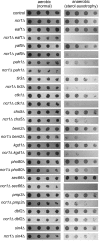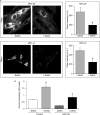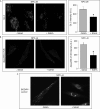An "exacerbate-reverse" strategy in yeast identifies histone deacetylase inhibition as a correction for cholesterol and sphingolipid transport defects in human Niemann-Pick type C disease
- PMID: 21489983
- PMCID: PMC3129166
- DOI: 10.1074/jbc.M111.227645
An "exacerbate-reverse" strategy in yeast identifies histone deacetylase inhibition as a correction for cholesterol and sphingolipid transport defects in human Niemann-Pick type C disease
Abstract
Niemann-Pick type C (NP-C) disease is a fatal lysosomal lipid storage disorder for which no effective therapy exists. A genome-wide, conditional synthetic lethality screen was performed using the yeast model of NP-C disease during anaerobiosis, an auxotrophic condition that requires yeast to utilize exogenous sterol. We identified 12 pathways and 13 genes as modifiers of the absence of the yeast NPC1 ortholog (NCR1) and quantified the impact of loss of these genes on sterol metabolism in ncr1Δ strains grown under viable aerobic conditions. Deletion of components of the yeast NuA4 histone acetyltransferase complex in ncr1Δ strains conferred anaerobic inviability and accumulation of multiple sterol intermediates. Thus, we hypothesize an imbalance in histone acetylation in human NP-C disease. Accordingly, we show that the majority of the 11 histone deacetylase (HDAC) genes are transcriptionally up-regulated in three genetically distinct fibroblast lines derived from patients with NP-C disease. A clinically approved HDAC inhibitor (suberoylanilide hydroxamic acid) reverses the dysregulation of the majority of the HDAC genes. Consequently, three key cellular diagnostic criteria of NP-C disease are dramatically ameliorated as follows: lysosomal accumulation of both cholesterol and sphingolipids and defective esterification of LDL-derived cholesterol. These data suggest HDAC inhibition as a candidate therapy for NP-C disease. We conclude that pathways that exacerbate lethality in a model organism can be reversed in human cells as a novel therapeutic strategy. This "exacerbate-reverse" approach can potentially be utilized in any model organism for any disease.
Figures








Similar articles
-
Itraconazole and posaconazole, inhibitors of NPC1 sterol transport, act as pharmacological chaperones after washout.J Biol Chem. 2025 Jul;301(7):110370. doi: 10.1016/j.jbc.2025.110370. Epub 2025 Jun 16. J Biol Chem. 2025. PMID: 40516874 Free PMC article.
-
Exploration of Bromodomain Proteins as Drug Targets for Niemann-Pick Type C Disease.Int J Mol Sci. 2025 Jun 16;26(12):5769. doi: 10.3390/ijms26125769. Int J Mol Sci. 2025. PMID: 40565243 Free PMC article.
-
Vorinostat, a histone deacetylase (HDAC) inhibitor, promotes cell cycle arrest and re-sensitizes rituximab- and chemo-resistant lymphoma cells to chemotherapy agents.J Cancer Res Clin Oncol. 2016 Feb;142(2):379-87. doi: 10.1007/s00432-015-2026-y. Epub 2015 Aug 28. J Cancer Res Clin Oncol. 2016. PMID: 26314218 Free PMC article.
-
The Black Book of Psychotropic Dosing and Monitoring.Psychopharmacol Bull. 2024 Jul 8;54(3):8-59. Psychopharmacol Bull. 2024. PMID: 38993656 Free PMC article. Review.
-
Signs and symptoms to determine if a patient presenting in primary care or hospital outpatient settings has COVID-19.Cochrane Database Syst Rev. 2022 May 20;5(5):CD013665. doi: 10.1002/14651858.CD013665.pub3. Cochrane Database Syst Rev. 2022. PMID: 35593186 Free PMC article.
Cited by
-
Histone deacetylase inhibition decreases cholesterol levels in neuronal cells by modulating key genes in cholesterol synthesis, uptake and efflux.PLoS One. 2013;8(1):e53394. doi: 10.1371/journal.pone.0053394. Epub 2013 Jan 10. PLoS One. 2013. PMID: 23326422 Free PMC article.
-
Quantitative Analysis of the Proteome Response to the Histone Deacetylase Inhibitor (HDACi) Vorinostat in Niemann-Pick Type C1 disease.Mol Cell Proteomics. 2017 Nov;16(11):1938-1957. doi: 10.1074/mcp.M116.064949. Epub 2017 Aug 31. Mol Cell Proteomics. 2017. PMID: 28860124 Free PMC article.
-
Normalization of Hepatic Homeostasis in the Npc1nmf164 Mouse Model of Niemann-Pick Type C Disease Treated with the Histone Deacetylase Inhibitor Vorinostat.J Biol Chem. 2017 Mar 17;292(11):4395-4410. doi: 10.1074/jbc.M116.770578. Epub 2016 Dec 28. J Biol Chem. 2017. PMID: 28031458 Free PMC article.
-
Adenovirus RIDα uncovers a novel pathway requiring ORP1L for lipid droplet formation independent of NPC1.Mol Biol Cell. 2013 Nov;24(21):3309-25. doi: 10.1091/mbc.E12-10-0760. Epub 2013 Sep 11. Mol Biol Cell. 2013. PMID: 24025716 Free PMC article.
-
Glucocerebrosidase and its relevance to Parkinson disease.Mol Neurodegener. 2019 Aug 29;14(1):36. doi: 10.1186/s13024-019-0336-2. Mol Neurodegener. 2019. PMID: 31464647 Free PMC article. Review.
References
Publication types
MeSH terms
Substances
Grants and funding
LinkOut - more resources
Full Text Sources
Other Literature Sources
Medical
Molecular Biology Databases
Miscellaneous

